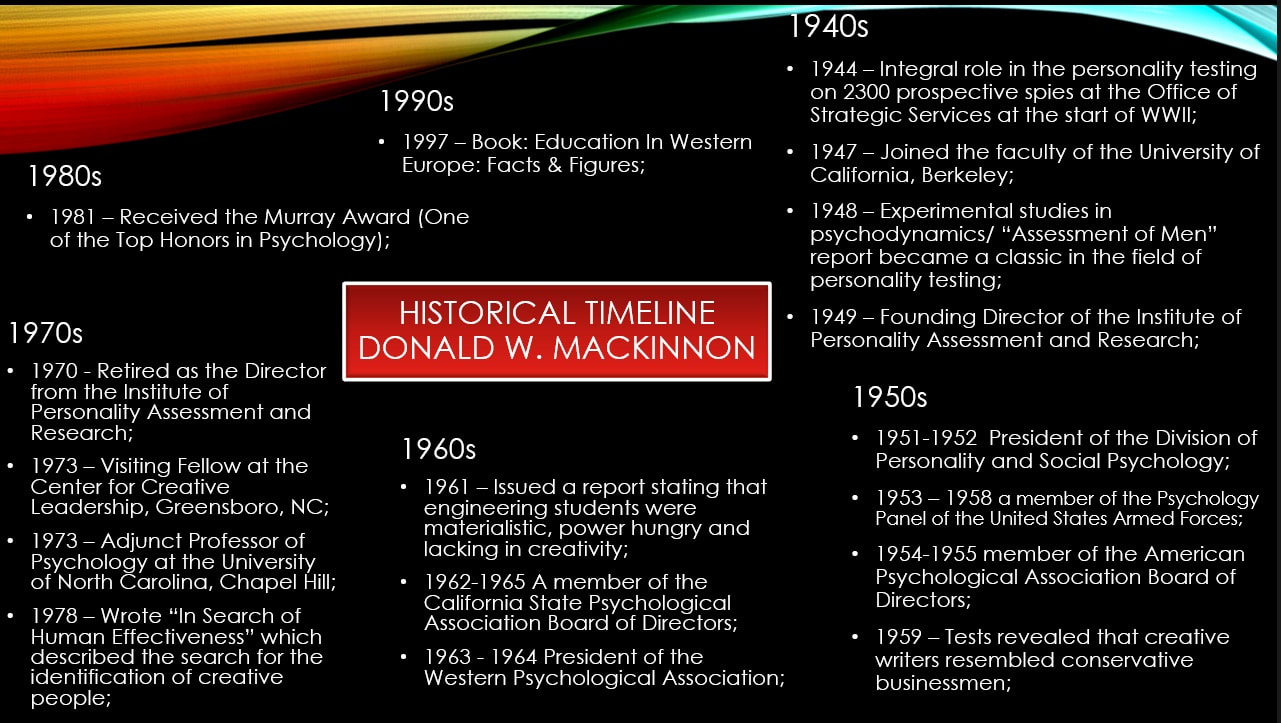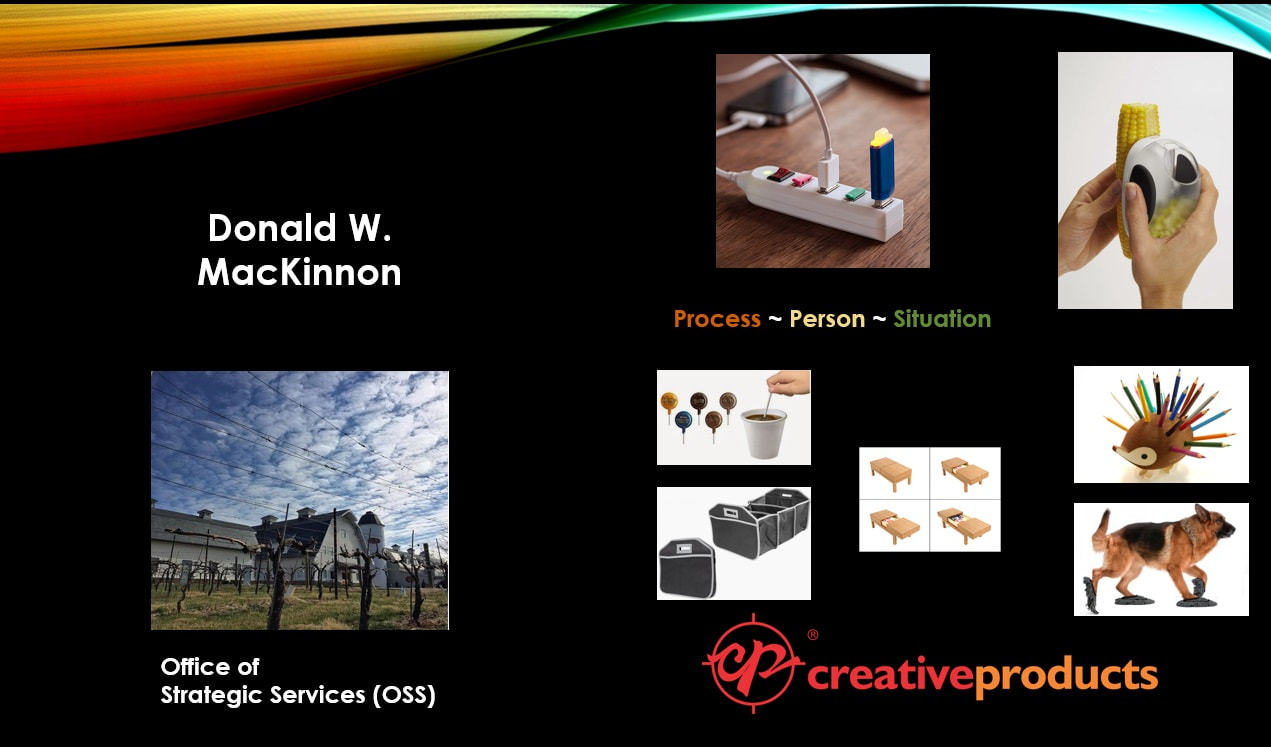|
Get Creative Activity This Get Creative Activity is focused on the works of Frank Xavier Barron (RIP). As I read about Dr. Barron, I reflected on our similarities in our life’s work. We both began our life’s journey in the military at a time when the United States was in battle overseas. Dr. Barron served during World War II, and I served during the Saudi Arabia conflict and the Iraq War. We both completed educational goals while serving in the military. Truth be told, I also wanted to major in Psychology. I was discouraged and told I would need a Doctorate Degree in Psychology to be successful in the field. At that young age, the thought of a Doctorate Degree was overwhelming, and I had never known anyone with a Doctorate Degree. As life may have it, I now find myself in a Psychology related field of which, as Barron was, I am very interested. Barron and I understand the value and importance of the role of personality and human creativity. Like Barron, my goal is to continue to carry out research in the field of creativity and make a difference. Barron’s focus on creativity from the perspective of collaboration is the area of concentration of my research. It supports my focus on the people side of change and contributes to the philosophical and methodological approaches to group interaction. In my research, I will show how this methodology reinforces the most effective practices for propelling successful workforce change. References Arons, M. (2003). A Tribute To Frank Barron: He Helped Bend A Century. Journal of Humanistic Psychology, 26-33. Barron, F. (1969). Creative Person and Creative Process. New York: Holt, Rinehart and Winston. Barron, F. (1995). No rootless flower: An Ecology of Creativity. Cresskill: Hampton Press. Barron, F. (1997). Creators on Creating: Awakening and Cultivating the Imaginative Mind. New York: GP Putnam's Sons. Goode, E. (2002, October 13). F. X. Barron, 80; Studied Science of Creativity. Retrieved from New York TImes: https://www.nytimes.com/2002/10/13/us/f-x-barron-80-studied-science-of-creativity.html
0 Comments
Diagnostic Thinking
Often as a Change Manager, the scope of my work is focused on implementing the change according to the Change Management Plan. As a contractor, I rarely am afforded the opportunity to assist with the analysis of the problem until the plan created by someone high up within the organization no longer seems feasible. Diagnostic Thinking is a very important to the success of any change implementation. According to Ranjay Gulati, speaker for the Harvard Business Review, Diagnostic Thinking is an essential quality of an effective leader. When diagnosing problems within the organization, it is important to look at the problem and taking the time to diagnose the problem correctly as opposed to just jumping straight to the solution that first comes to mind as the ideal solution. It is so common for leaders to just think they have the solution and implement without proper analysis of the problem. The Monograph by Donald MacKinnon on the OSS Assessment Program, “How Assessment Centers Were Started in the United States,” depicts a scenario where diagnostic thinking was absent and leaders displayed more action-oriented decision making behavior. In search of people who would make good spies or good guerilla fighters, someone decided the most logical selection would be to recruit murders and gang members. As a result, the outcome was disastrous. The powers to be realized that a more diagnostic thinking process was needed and sought the assistance of Psychologist, similar to that of the psychological/psychiatric assessment used in the English War Office Selection Boards, to be set up for the OSS. This was a step in the direction but still lacked the elements of diagnostic thinking. Once again, this “action oriented” mindset lead to a hasty and premature initiation of the assessment program. The program suffered because Psychologists were tasked with determining the type of person who would be best suited for the job without knowledge of what these jobs were. Without any analyses of these jobs, these Psychologists could not possibly know what they were assessing. Being a retired military person, this really hit home. Unfortunately, the military continues to make decisions in haste and often lacks diagnostic thinking. This behavior is not just found in the military, but in civilian/commercial organizations also. I found this monograph by Donald Mackinnon to be a great example of what happens in the absence of diagnostic thinking. Works CitedGulati, R. (2013, March 12). Diagnostic Thinking. Retrieved from Harvard Business Review: https://hbr.org/video/2226699673001/diagnostic-thinking MacKinnon, D. W. (2005). How Assessment Centers were Started in the United States. Retrieved from Development Dimension International (DDI) World : https://www.ddiworld.com/DDI/media/monographs/HowAssessmentCentersWereStarted_mg_ddi.pdf?ext=.pdf Breakthrough, Expand the Boundaries
Alex Osborn This week, as I reflected on my first days in the program, I recall taking the challenge that although I didn’t find myself to be a very creative person, I was going to learn enough about it to get a better understanding of how it worked in “Creative People.” I didn’t think for a moment that I could possibly be a creative person. My focus was on my practice in Organizational Change Management. I wanted to find more creative ways to bring my clients the solutions they need and want. Alex Osborn’s perspective on creativity was music to my ears! He went against status quo which was of the belief that only people who had this innate talent could be creative. Instead, Osborn believed that anyone could be creative even if it meant teaching or guiding them through a creative process. He further introduced brainstorming, which was an intricate part of stimulating the creative thought process. In 1945, brainstorming and creative problem solving gained popularity in Osborn’s book Applied Imagination: Principles and Procedures of Creative Problem Solving. Osborn is noteworthy for: (1) Founding the Creative Education Foundation (CEF) in 1954 (2) Co-Founding the Creative Problem Solving Institute (CPSI) in 1954 (3) Co-created with Sidney Parnes, the Osborn-Parnes Creative Problem Solving Process (CPS) (4) CEF sponsored a Leadership Convocation of the pioneers of the Creative Thinking Movement (1960) I have truly benefited from Osborn’s work in the field of Creativity. His research provided additional skills for me in my Change Management toolbelt. Knowledge of Creative Problem Solving (CPS) allows me to better serve clients by helping them to find the best solutions. Works CitedOsborn, A. (1948). Your Creative Power: How to Use Imagination. New York: Charles Scribner's Sons. Osborn, A. (1952). Wake Up Your Mind: 101 Ways To Develop Creativeness. New York: Charles Scribner's Sons. Osborn, A. (1963). Applied Imagination: Principles and Procedures of Creative Problem-Solving. New York: Charles Scribner's Sons. Glimpse of the Future
Anna Craft research interest was primarily in the future of education and learning. As we moved into the computer age, Craft recognized that there were opportunities to create new approaches to learning. She explored the way youth’s childhood was changing and the potential need to change the way we might need to change our education system. Transforming our education system was a top priority and focusing educational design on imaginative education futures. Craft’s research was exceptionally interesting to me because of my passion to make a change to our educational system in the Virgin Islands. I would love to create Craft’s vision for an education system where learning occurs naturally as play on the playground. Her writing is very inspirational as to the possibilities of “fostering imagination and creativity in all aspects of children’s learning.” Craft’s dedication and commitment to the work in the field of creativity in all aspects of children’s learning is beyond commendable. Works CitedCraft, A. (Ed.). (2005). Creativity in Schools: Tensions and Dilemmas. New York: Routledge. Craft, A. (2006). Creativity Across the Primary Curriculum. New York: Routledge. Craft, A. (2010, November). Creativity and Education Futures: Learning in a Digital Age. Staffordshire: Trentham Books Ltd. Retrieved from Eric: https://eric.ed.gov/?id=ED523399 Craft, A. J. (Ed.). (2001). Creativity in Education. London: Biddles Ltd. As I continue to prepare for my dissertation, my mind floats around the logical path of getting leaders to fully understand the value of creative facets of leadership such as appreciative inquiry and the most effective use of personality types. In my studies, I have found these two areas to be very important to the success of an organization. Similar to organized change management practices, I find that leaders often take the importance of these two valuable processes lightly. According to Maxwell (2007), if you want lasting improvement, you must rely on a process. Although these processes encourage workforce development, helps build maturity in employees, it may often be difficult to implement. A leader should not be discouraged. Maxwell (2007) later leads us through the process of the Law of Navigation where he discusses the importance of a leader carefully chartering the course of the organization. This Law of Navigation, examines the conditions before committing to the organization’s next steps. I propose that as leaders strategize their change implementations, they should consider all aspects of this law of navigation, the variables. For example, identifying personality traits prior to role selection is important to effectively executing the tasks. Not having the right people positioned may not necessarily equate to failure but may cause a delay in the process. Using Appreciative Inquiry sets the climate and using a model, such as FOURSIGHT, ensures that tasks would be assigned more appropriately.
Works Cited(n.d.). Retrieved from FourSight: https://foursightonline.com/ Maxwell, J. C. (2007). The 21 Irrefutable Laws of Leadership. New York: Harper Collins Leadership. Thathenkery, T. (2005). Appreciative Sharing of Knowledge: Leveraging Knowledge Management for Strategic Chang. New Mexico: Tao Institute Publications. Donald Wallace MacKinnon
Psychologist and Professor Emeritus Donald Wallace MacKinnon was born on January 9, 1903, in Augusta, Maine. EDUCATION
This topic was so appropriate for me this week because I found myself lacking courage. At first, I was stomped by the task of an “E-Organizer.” I did, however, recognize that it was a new process to me and a very creative way of sharing notes. I had learned so much in this program so far, that when I learned that there was still something else new, a new process (E-Organizer), I honestly became somewhat discouraged. But not for long. I welcomed this new learning opportunity.
Having strong “Clarifier” qualities, I have little or no tolerance for risk. Accomplishing tasks is always a high priority for me. The risks of not figuring out the E-Organizer weighed heavily on me. I courageously moved forward and took the experience head-on. I reflect on what I now consider to be this minor task, which felt enormous two weeks ago. Puccio, etal. encourage us not to be shaken by complex tasks. Failures and setbacks are all part of the learning experience. One should have the courage to persevere and not give up. Works Cited Puccio, G. M. (2011). Creative Leadership: Skills That Drive Change. New York: Sage Publications. |
Stacy Creque-Smoot
Student of Creative Learning & Processes Archives
May 2019
Categories |
||||||



 RSS Feed
RSS Feed
